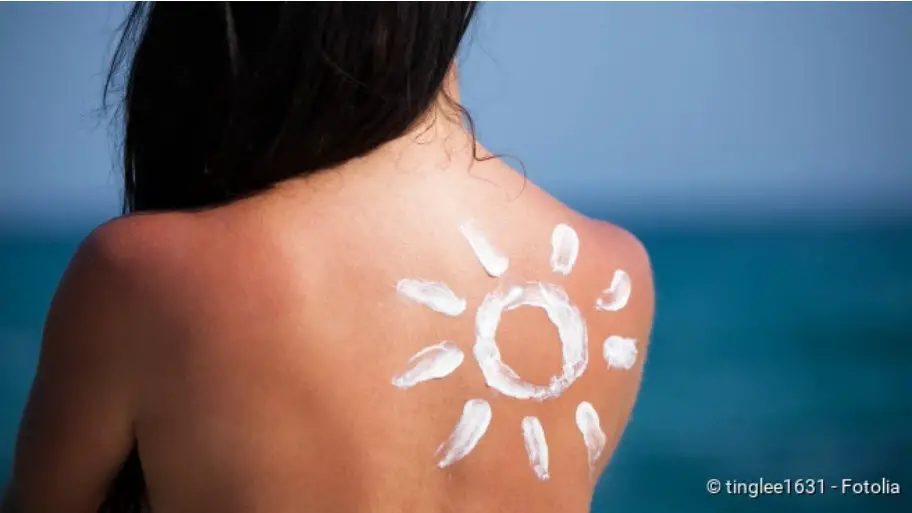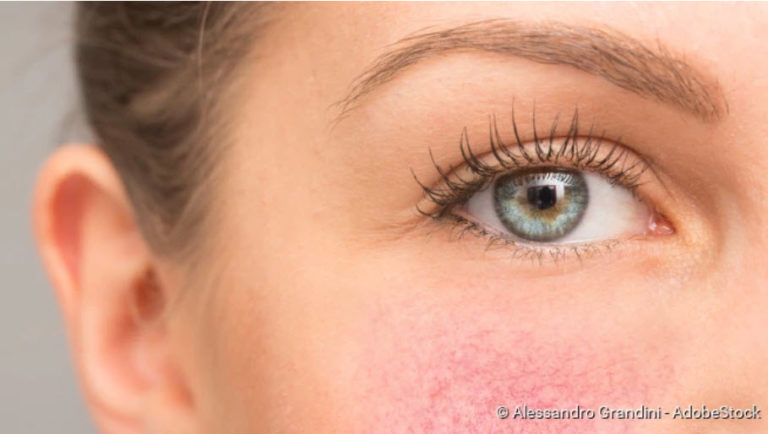Sun allergy: description, trigger, symptoms, treatment
Sun allergy: description, trigger, symptoms, treatment
A sun allergy is actually not a real allergy in most cases. The colloquial term rather describes various diseases that are triggered by a reaction to sunlight. What they all have in common is that the body’s natural protective mechanism against UV rays fails, resulting in symptoms such as itchy, burning skin and blisters or wheals. Find out here why an allergy to the sun occurs at all and how it can be alleviated or even avoided!

Brief overview
- What is sun allergy? Usually no real allergy, but a hypersensitivity to UV radiation.
- Symptoms: may vary individually, often itching, redness, blisters or blisters
- Treatment: cool, moisturize, in severe cases possibly medication or habituation by preliminary irradiation by the doctor
- Causes: not conclusively clarified; allergens or free radicals (aggressive oxygen compounds) are suspected
- Diagnosis: patient interview, light test
- Prognosis: In the course of time, the skin gets used to the sun and the symptoms may gradually decrease. However, those affected by a sun allergy never completely get rid of it.
Solar allergy: Description
Typical symptoms of sun allergy such as itching and reddened skin are similar to the symptoms of “real” allergies (like nickel allergy). Actually, however, a sun allergy is usually not a classic allergy, i.e. an overreaction of the immune system (exception: photoallergic reaction). Instead, the body of the affected person can no longer protect itself sufficiently from the sun’s rays. Normally, it reacts to sunlight with an increased production of skin pigments: this so-called melanin makes the skin look brown and protects the genetic material in the cells from the damaging UV radiation in sunlight, i.e. the ultraviolet A (UV-A) and ultraviolet B (UV-B) rays. In case of a sun allergy, this protective mechanism of the skin is impaired. The consequences are for example itching, blistering or reddening of the skin.
By far the most common form of sun allergy is polymorphic light dermatosis (PLD). Younger adults (women more often than men) and children are particularly affected.
Sun allergy in children
Some children also suffer from an allergy to the sun. Infants and babies should generally be given a high sun protection factor before being exposed to the sun. At this age the body’s own protective mechanism against UV radiation is not yet fully developed. As a result, the little ones get sunburn or sun allergy faster. The latter is most often seen on the face. Particularly affected are the so-called “sun terraces” such as nose, forehead and chin. In adults, these areas are often already accustomed to sunlight, but not in children. That is why a headgear (also for adults) is advisable – especially as it not only protects against sun allergy, but also against sunstroke.
Sun allergy: symptoms
The symptoms of a sun allergy are different, depending on its severity and type. Sometimes they also occur with a delay, so that it is not at all easy for laypersons to identify the sun as the “culprit”.
Polymorphic light dermatosis (PLD) accounts for about 90 percent of all cases of sun allergy. It often affects fair-skinned young women. Mostly it appears on those parts of the body that are not used to the sun (décolleté, shoulders, neck, extensor sides of the arms and legs). The symptoms can be individually very different (hence the name addition polymorph = multiform). In addition, they often show up with a delay: this solar allergy only triggers symptoms hours or days after exposure to the sun:
- The skin begins to itch and burn (itching).
- The skin discolours, reddish spots appear (skin redness).
- Bubbles, nodules or even blisters develop.
- The skin may swell.
- In case of sun allergy, the skin becomes particularly sensitive to UV rays due to certain substances. It manifests itself in reddening of the skin, itching and often blisters.
Apart from polymorphic light dermatosis there are other types of sun allergy which manifest themselves somewhat differently. These include:
Phototoxic reaction: Chemical substances – so-called photosensitizers – make the skin more sensitive to light. Sun allergy symptoms and an increased tendency to sunburn are the consequences. Sometimes the phototoxic reaction is triggered by skin contact with photosensitizers (application of perfumes, touching photosensitizing plants, etc.) However, photosensitisers can also trigger sun allergy via the bloodstream or the digestive tract, for example some medicines and foods. The skin of those affected reacts to sunlight with itching, burning pain or discoloration. Severe sunburn can also occur.
Photoallergic reaction: This rare form of sun allergy is a real light allergy (photoallergy). The body forms antibodies, i.e. defence substances that are directed against a certain substance such as a medicine (e.g. antibiotics), cosmetics, make-up or a perfume. At the next contact in connection with solar radiation, the antibodies attack the substance – an allergic reaction occurs. The symptoms of photoallergy are similar to those of phototoxic reactions. It is therefore often difficult to differentiate between the various forms of solar allergy.
Mallorca acne (Acne aestivalis): Also called summer acne. This form of sun allergy is considered a special form of polymorphic light dermatosis. It manifests itself in pinhead-sized knots and skin spots that itch heavily. The nodules resemble acne pustules. In fact, this form of sun allergy is particularly common in people who are prone to acne or oily skin.
Light urticaria (Urticaria solaris): It is rare, but must be taken seriously! In those affected, the skin shows an abnormal reaction to sunlight – itchy wheals form, similar to the sensation after touching a nettle. After a few minutes to hours they disappear again. If larger areas of skin are affected, general symptoms such as nausea or a drop in blood pressure (including dizziness) can be added.
Most often the sun allergy symptoms occur when the skin has not been exposed to sunlight for a long time. In spring and during beach holidays, allergies to the sun are therefore particularly common.
Treatment: Solar allergy – what to do?
If symptoms of a sun allergy occur, one should stay away from sunlight as much as possible. If this is not possible, one should cover the skin with clothing (long trousers, long sleeves, hat) and use sun cream with a sufficiently high sun protection factor (SPF). In case of photoallergic as well as phototoxic reactions it is also necessary to avoid the triggering substance.
The symptoms of a sun allergy can be alleviated with dairy products (e.g. a cottage cheese package) and – in severe cases – with medication:
Sun allergy treatment with dairy products: If the skin has been exposed to excessive sunlight and is reacting with a sun allergy, you should cool and moisturize it. Cooling envelopes with buttermilk, quark or yoghurt from the refrigerator do just that. The coolness causes the vessels to contract and any swelling to subside. The moisture helps the damaged skin to recover.
Medicinal therapy for sun allergy: Medicines are used in severe cases of sun allergy. So-called antihistamines in ointment or tablet form can reduce itching, for example in the case of Mallorca acne or light urticaria. Sometimes the doctor also prescribes preparations containing cortisone to stop the inflammatory reactions of the skin. This may be necessary in the case of a photoallergic reaction.
If general symptoms such as nausea and a drop in blood pressure occur during light urticaria, a doctor should be called immediately!
Sun allergy: preventive treatment
Sun allergy patients can do a lot to prevent itching, blistering, etc. from occurring in the first place:
Use sufficient sunscreen:
The most important thing is that you always ensure that you have sufficient sun protection. Of course this also applies if you are not allergic to the sun! UV rays increase the risk of skin cancer. Use a good sunscreen that offers at least SPF 30. It should also be as free as possible from preservatives and colourings.
Apply the sunscreen about 45 minutes before going out in the sun. Then it has enough time to take effect. How long the protection lasts can be estimated using the following formula: Self-protection factor (depending on skin type approx. 5-45 minutes) x sun protection factor = protected minutes in the sun
With a sun protection factor (SPF) of 30 and the light skin type frequently found in this country, this would mean: 10 minutes x 30 = 300 minutes. To be on the safe side, however, only 60 percent of this calculated time span should actually be spent in the sun. By the way: If you sweat a lot or go swimming in between, you should apply more cream.
If there are signs of acne, you should only use oil-free sun protection products (such as special gels) and skin care products. Please see our article about acne where we explain it in more detail.
Wear clothes:
Clothing also protects against the sun’s rays, especially if it is made of a material that is not very translucent. Hats, scarves and blouses, for example, can also partially block UV rays from the skin on the beach.
Stay inside:
The radiation is most intensive at midday, which is why you should stay indoors. Window panes usually block a large part of the harmful radiation. Patients who are allergic to the sun should possibly still apply protective films.
Phototherapy:
In case of very strong sun allergy (e.g. severe polymorphic light dermatosis) phototherapy may be useful. In spring or some time before a planned holiday trip to the south, the skin is slowly accustomed to the sun’s rays. For this purpose, she is irradiated with increasing doses of UV light in several sessions. It is possible that an active substance is applied beforehand which makes the skin more sensitive to light. Then one speaks of photochemotherapy or PUVA (psoralen UV-A phototherapy).
You must never carry out phototherapy on your own – mistakes can cause extensive skin burns! Leave the procedure to a dermatologist.
Catching free radicals:
Some experts are of the opinion that the most frequent sun allergy (polymorphic light dermatosis) can be caused by free radicals, i.e. reactive oxygen compounds (see “Causes”). They therefore recommend the intake of so-called antioxidants (“radical scavengers”) to prevent the symptoms of a sun allergy. These include calcium, omega-3 fatty acids, folic acid, vitamin E and beta-carotene. The effectiveness of antioxidants has not yet been scientifically proven. Nevertheless, many of those affected report an improvement in their symptoms. Discuss the intake of such radical scavengers with your doctor in advance.
Smokers should not take beta-carotene as it can further increase the risk of lung cancer – which is already increased by niktoin anyway.
Getting help:
Allergy to the sun can affect social life. Some of those affected suffer so much that they develop a depressive mood. What you should then do is ask your doctor for advice and, if necessary, get professional psychotherapeutic support.
Solar allergy: causes and risk factors
In polymorphic light dermatosis (PLD), the skin’s protective mechanism against UV rays does not function properly: when sun rays hit the skin, the body normally reacts by producing more melanin. This is a skin pigment that is supposed to protect the genetic material from the damaging UV rays. The skin turns brown due to the melanin. People from southern countries, where the sun shines a lot, therefore generally have a darker skin colour. The more often a body is exposed to the sun, the more it normally gets used to the harmful rays.
This is not the case with polymorphic light dermatosis: The skin of the affected persons usually reacts hypersensitively to the UV-A rays in sunlight. Sometimes UV-B rays or both types of rays are also the trigger of this solar allergy. The reason for this is unknown. There are, however, different approaches to explain this:
Some scientists believe that allergens are formed in the body by the sun’s rays. Allergens are substances that activate the immune system so that it fights the supposedly harmful substance – just like in a conventional allergy. However, this explanatory approach has not yet been confirmed.
According to another theory, aggressive oxygen compounds (free radicals) are formed in the skin under sunlight, which is the cause of sun allergy. They can damage cells and increase the risk of skin cancer. The damage to skin cells by free radicals could also activate the immune system – with the consequence of symptoms of polymorphic light dermatosis. However, even this assumption could not yet be clearly proven.
The phototoxic reaction is triggered by the interaction between UV-A light, human cells and a chemical substance. the latter can be, for example, a drug substance, certain ingredients of perfumes or cosmetics or plant substances (furanocoumarins).
The photoallergic reaction is caused by the fact that the immune system reacts allergic to certain substances under the influence of UV light. As in the case of phototoxic reactions, these can be ingredients of drugs or cosmetics, for example.
Mallorca acne is caused by the interaction of UV-A rays with components of fatty sun cream or the body’s own sebum in the uppermost skin layers. Whether the immune system is involved has not yet been conclusively determined.
The exact cause of light urticaria is unclear. However, it is known that the symptoms are triggered by the UV-A component in sunlight.
Solar allergy: examinations and diagnosis
If a sun allergy is suspected, the doctor will first discuss your medical history with you (anamnesis). In doing so, he enquires for example about
- the nature and progress of the complaints
- any medication you may be taking
- possible pre-existing conditions
In the vast majority of cases, sun allergy is a polymorphic light dermatosis. Rarely is another form of solar allergy behind it. To confirm the diagnosis, the doctor can carry out a light test by irradiating certain areas of the skin with ultraviolet light. In case of a polymorphic light dermatosis the typical symptoms appear after a few hours on the treated areas.
In the case of a sun allergy in combination with chemical substances such as phototoxic reaction, the doctor can apply suspicious triggers (such as ingredients of cosmetics) to suitable skin areas and then irradiate them. This photo patch test can be used to find out exactly what causes the skin symptoms in combination with UV light.
If light urticaria is suspected, the light test must be performed very carefully: The symptoms, which usually appear within minutes, can be quite severe. Occasionally there are also severe general symptoms such as a drop in blood pressure, circulatory shock and shortness of breath. Therefore, the test should only be performed by physicians who are prepared for such emergencies.
Solar allergy: course of disease and prognosis
Unfortunately an allergy to the sun is not curable. People who are hypersensitive to sunlight will have this problem throughout their lives. However, it is possible that the symptoms will decrease over time as the skin gets used to the sun. The extent to which those affected suffer from the symptoms varies from person to person and depends above all on the particular form of light allergy. However, through correct behaviour, preventive measures and various therapy concepts, severe outbreaks can usually be prevented and the symptoms of a sun allergy can be significantly alleviated.





